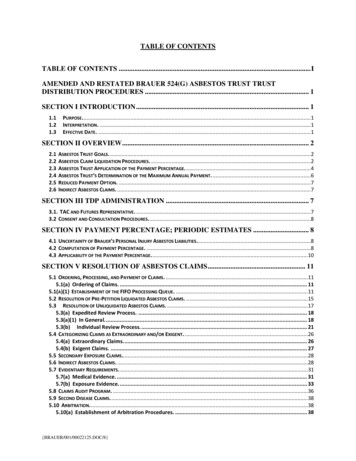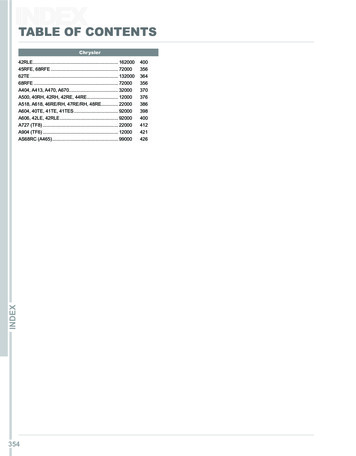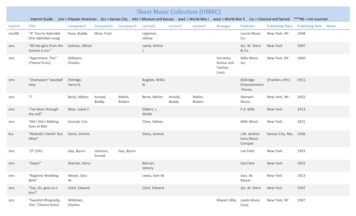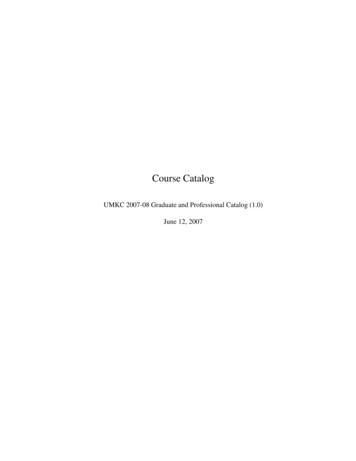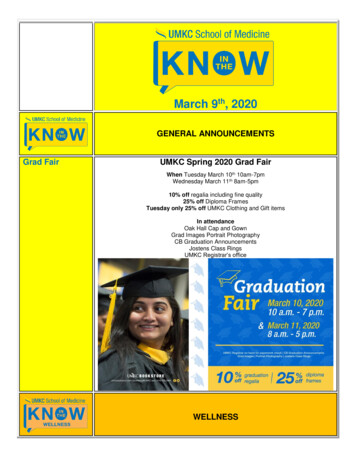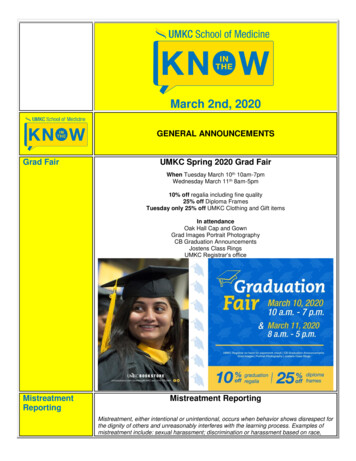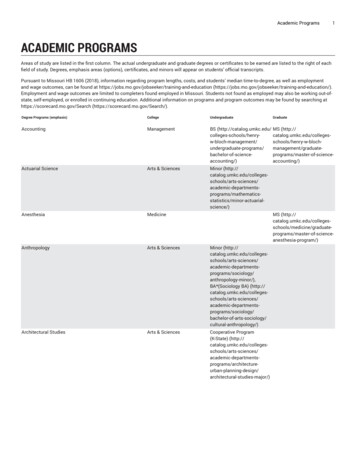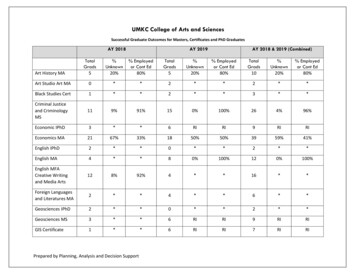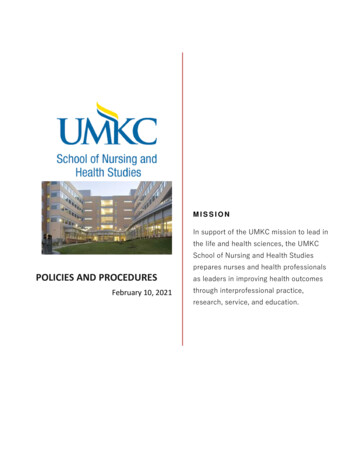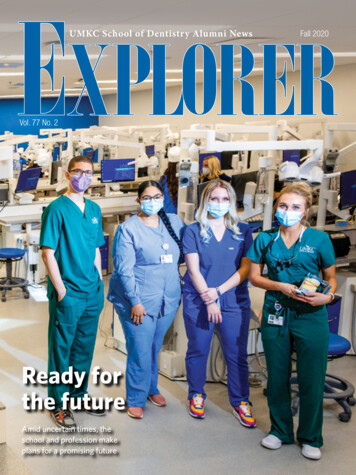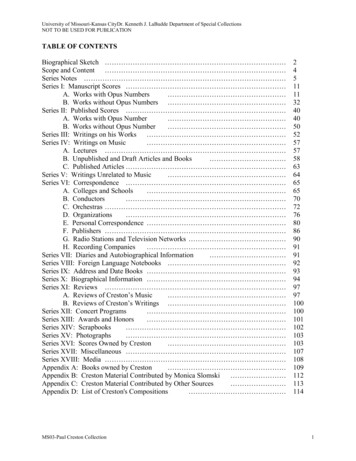
Transcription
University of Missouri-Kansas CityDr. Kenneth J. LaBudde Department of Special CollectionsNOT TO BE USED FOR PUBLICATIONTABLE OF CONTENTSBiographical Sketch Scope and Content Series Notes Series I: Manuscript Scores A. Works with Opus Numbers B. Works without Opus Numbers Series II: Published Scores A. Works with Opus Number B. Works without Opus Number Series III: Writings on his Works Series IV: Writings on Music A. Lectures B. Unpublished and Draft Articles and Books C. Published Articles Series V: Writings Unrelated to Music Series VI: Correspondence A. Colleges and Schools B. Conductors C. Orchestras D. Organizations E. Personal Correspondence F. Publishers G. Radio Stations and Television Networks H. Recording Companies Series VII: Diaries and Autobiographical Information Series VIII: Foreign Language Notebooks Series IX: Address and Date Books Series X: Biographical Information Series XI: Reviews A. Reviews of Creston’s Music B. Reviews of Creston’s Writings Series XII: Concert Programs Series XIII: Awards and Honors Series XIV: Scrapbooks Series XV: Photographs Series XVI: Scores Owned by Creston Series XVII: Miscellaneous Series XVIII: Media Appendix A: Books owned by Creston Appendix B: Creston Material Contributed by Monica Slomski Appendix C: Creston Material Contributed by Other Sources Appendix D: List of Creston's Compositions MS03-Paul Creston 1141
University of Missouri-Kansas CityDr. Kenneth J. LaBudde Department of Special CollectionsNOT TO BE USED FOR PUBLICATIONBIOGRAPHICAL SKETCHPaul Creston was born Giuseppe Guttovergi on October 10, 1906, in New York City to Italianimmigrant parents, Gaspare Guttovergi and Carmela Collura. At age eight, he began takingpiano lessons and teaching himself how to play his brother’s violin. Creston also pursued aninterest in literature, writing his first poem at age twelve, and starting a novel a year later.Because of poor family finances, Creston’s formal education ended after two and one-half yearsof high school. During high school, he was nicknamed “Cress” after a character he portrayed ina play. Later in life, he lengthened this name to Creston, chose Paul for a first name, and legallychanged his name to Paul Creston in 1944. Creston worked at various businesses, banks, andinsurance companies to pay for organ and piano lessons, while studying English, foreignlanguages, mysticism, music composition, and orchestration on his own. His piano teachersduring this period included Gaston Dethier, Carlo Stea, and G. Aldo Randegger.Although Creston had been composing as a diversion or past-time since age eight, hisdevelopment as composer increased during the 1920s until 1932, when he finally decided tochoose composition as his career. Creston learned how to improvise by working as a theaterorganist from 1926-1929, and eventually became the organist at St. Malachy’s Church in NewYork City from 1934 to 1967. In July of 1927, Creston married a dancer, Louise Gotto (19031989), who influenced Creston in his ideas on rhythm and dance. His first premiere was in 1933with the incidental music to a play Iron Flowers. The Crestons’ first child, Paul Julian, survivedonly six weeks and was buried on the Crestons’ tenth wedding anniversary, July 1, 1937. But onThanksgiving Day, 1938, the Crestons were blessed with a healthy boy, Joel Anthony, and fouryears later, they had their third and last child, Timothy.The success of Creston’s early compositions created many new opportunities for him. From1944 to 1950, Creston conducted a quartet on the radio program, The Hour of Faith, which airedeach Sunday morning. Creston also worked as a composition instructor at over fourteen collegesand universities between the years of 1940 and 1962. In 1960, Creston received a U.S. StateDepartment grant as an American specialist, which enabled him to lecture about American musicfor over a month in Turkey and Israel. He served as Professor of Composition and Orchestrationat New York College of Music between 1963 and 1967, and in 1968, he became artist-inresidence at Central Washington State College in Ellensburg, Washington. During this time, heappeared as guest conductor and lecturer at many colleges and universities across the country. In1975, he retired from Central Washington State College and moved to Rancho Bernardo,California, which lies on the outskirts of San Diego.Creston wrote 120 compositions with opus numbers including piano pieces, songs, chambermusic for various instruments, choral works, symphonic band works, and over 35 orchestralworks including six symphonies. He is especially recognized for his contributions to theliterature of neglected instruments such as the marimba, trombone, harp, accordion, andsaxophone. His works have been widely performed by major orchestras and performing artists.In an orchestral survey prepared by Robert Sabin in the late 1950s, Creston and Aaron Coplandshared first place in regard to the number of orchestra compositions and their performances bymajor American symphony orchestras.MS03-Paul Creston Collection2
University of Missouri-Kansas CityDr. Kenneth J. LaBudde Department of Special CollectionsNOT TO BE USED FOR PUBLICATIONCreston also composed works without opus numbers, especially for radio, television, and film.He composed for the children’s radio program Storyland Theatre and for the dramatic portions ofthe radio program Philco Hall of Fame. Creston also contributed scores to the CBS-TV seriesThe Twentieth Century, receiving a Christopher Award for the segment Revolt in Hungary. Thedocumentary on poet William Carlos Williams, In the American Grain, earned Creston an Emmyaward. In addition, Creston wrote numerous articles for music journals and authored twopublished books: Principles of Rhythm and Rational Metric Notation.Among Creston’s awards and honors are two Guggenheim Fellowships (1938, 1939), New YorkMusic Critics’ Circle Award (1943), Citation of Merit from the National Association forAmerican Composers and Conductors (1941), the Music Award of the American Academy ofArts and Letters (1943), and the Citation of Honor from the National Catholic Music EducatorsAssociation (1956).Paul Creston was diagnosed with cancer in 1984, and died on August 24, 1985.MS03-Paul Creston Collection3
University of Missouri-Kansas CityDr. Kenneth J. LaBudde Department of Special CollectionsNOT TO BE USED FOR PUBLICATIONSCOPE AND CONTENTThe Paul Creston Collection was donated to the University of Missouri-Kansas City by his wife,Louise Creston, in 1987. Organized into 18 series that occupy nearly 100 boxes, the manuscriptcollection is housed in LaBudde Special Collections and consists of published and unpublishedscores; music and non-music related writings, including correspondence, diaries, and notebooks;reviews and concert programs; awards and honors; scrapbooks, photographs and othermiscellaneous items. The earliest material in the collection are scores that date from 1922, andthe latest material in the collection are obituaries and programs from Louise Creston’s funeral in1989. Books owned by Creston as well as later donations to the collection by other sources canbe found in the Appendix series. Sound recordings from this collection – including records,cassettes and open-reel tapes – are housed in the Marr Sound Archives and can be accessedthrough that department’s collection inventory.The strength of the collection lies in the over 300 manuscript scores, representing over onehundred of Creston’s 121 works with opus numbers, and many of his works without opusnumbers, including radio, film and television scores. Many of the opus numbers, especiallythose with much instrumentation contain more than one score. Thus, Creston’s method ofcomposing can be followed from the rough draft to the final published copy. The majority of thescores also contain annotations by Creston. The collection also contains over 150 publishedscores, some of which are permanently out of print.Another strength of the collection is the correspondence. In handling correspondence, Crestonalways typed a letter, copied it, signed it, mailed the signed copy to the recipient, and kept theoriginal unsigned letter for his records. Thus the correspondence contains all of the letters,telegrams, and postcards sent to and from Creston.Other highlights of the collection include Creston’s writings on his own life and works, includingprogram notes from over 60 works, autobiographical sketches, lectures, diaries, and date booksfrom 1944 to 1985. Creston’s philosophy of life and music can be found in 11 notebooks keptby Creston on mysticism and occultism in the Writings Unrelated to Music series, which alsocontains 40 of his poems. Besides the music manuscripts, manuscripts of both published andunpublished books and articles by Creston are an important part of the collection. Over 200reviews of Creston’s music and 470 concert programs from 1932-1985 can be found in their ownseries as well as in scrapbooks that were organized by Louise. The Media series contains a smallassortment of audio/visual material of interviews and UMKC-sponsored events; however, themajority of this type of material (i.e., sound recordings) are housed separately in the Marr SoundArchives. Completing the collection are foreign language notebooks, biographical information,awards and honors, and scores and books owned by Creston, as well as over 130 photographs.Other excellent sources of information about Paul Creston are Monica Slomski’s dissertationPaul Creston: The Man and His Music with an Annotated Bibliography of his Works and herbook Paul Creston: A Bio-Bibliography.MS03-Paul Creston Collection4
University of Missouri-Kansas CityDr. Kenneth J. LaBudde Department of Special CollectionsNOT TO BE USED FOR PUBLICATIONSERIES NOTESSERIES I: MANUSCRIPT SCORESThis series consists of manuscript scores and copies of manuscripts composed by Creston fororchestra, chorus, chamber ensemble, band, vocal solo, and instrumental solo. Also included areunpublished transcriptions by Creston of works by J. S. Bach, music for radio and film, andexamples for teaching material. Creston’s first opus work in the series, Three Theses for Piano,contains comments and an autograph by composer Arnold Schoenberg. Two vocal songs writtenby Creston in the 1950s, “It’s So Fantastic” and “My Love for You” are credited to Paul Wedge,a pseudonym used by Creston. A large section of this series contains radio scripts and scores forStoryland Theatre, a children’s radio play produced weekly from December 1943 to September1944; Creston composed 5-8 repeatable themes for the show each week. Of Creston’s firsteighteen opus works, nine of them are found in this series and the rest (except Opus 5) can befound in the Published Music series. Opus numbers 5 and 70 are not in the Collection, becausethe manuscripts of Op. 5 are held by the publisher, Carl Fischer, and the pencil manuscript ofOp. 70 is at the Library of Congress. Many of the opus numbers, especially those with muchinstrumentation, contain more than one score. On the first copy, Creston often composed on just3 staves with no instrumentation stated. He would then add the instrumentation in a differentcolor of pencil on the reduced score, and finally write the full score. The majority of the scorescontain annotations by Creston. The series is divided into two sub-series: A. Works with OpusNumbers and B. Works without Opus Numbers. Sub-series A is arranged numerically by opusnumber, while sub-series B is arranged alphabetically by title (except Creston’s transcriptions ofBach material, which are interfiled under the latter composer’s name, then by title). Inclusivedates in the series are 1922-1982, with the majority of scores created between 1935 and 1982.Material is located in Boxes 1-21; Oversized Boxes 22-24; Oversized Box 25, Folders 1-12;Oversized Box 81; Oversized Box 82, Folders 1-5 and 8-12; and Oversized Box 83, Folder 1.SERIES II: PUBLISHED SCORESThis series consists of published scores composed by Creston for orchestra, chorus, chamberensemble, band, vocal solo, and instrumental solo. There are 33 opus numbers that do not havepublished scores in this series, but except for Opus 5 and 70, their manuscripts can be found inthe Manuscript Scores series. Also included in this series is an arrangement of J. S. Bach’sChaconne and transcriptions of his Chorale-Preludes created by Creston. Of particular note is a10-book course in rhythm for piano students entitled Rhythmicon. It presents meters andrhythms through explanatory notes, exercises, and short pieces. The series is divided into twosub-series: A. Works with Opus Numbers and B. Works without Opus Numbers. Sub-series A isarranged numerically by opus number, while sub-series B is arranged alphabetically by title(except Creston’s arrangement and transcriptions of Bach material, which are interfiled under thelatter composer’s name, then by title). Inclusive dates in the series are 1935-1984. Material islocated in Boxes 26-31 and Box 32, Folders 1-13; Oversized Box 2
saxophone. His works have been widely performed by major orchestras and performing artists. In an orchestral survey prepared by Robert Sabin in the late 1950s, Creston and Aaron Copland shared first place in regard to the number of orchestra compositions and their performances by major American symphony orchestras. University of Missouri-Kansas CityDr. Kenneth J. LaBudde Department of
